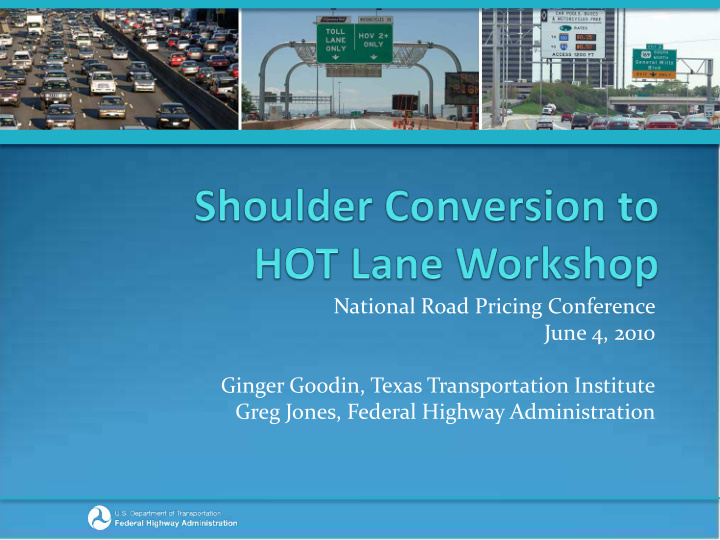



National Road Pricing Conference June 4, 2010 Ginger Goodin, Texas Transportation Institute Greg Jones, Federal Highway Administration
Workshop Purpose Provide hands-on practice in applying lessons learned and best practices from implemented projects across the country Understand the challenges in implementing pricing projects Move pricing forward in your area
Workshop Agenda Review of Project Break into groups for exercises Five subject areas covered 5-10 minute overview of subject area 35-40 minutes to complete exercise Break for lunch after second round of exercises Group reports
Subject Areas Planning Operations Design Funding and Finance Outreach No specific order, all have overlapping elements
Our Project Length: 15 miles 6 lanes with 10’ shoulders on both sides 165,000 AADT and growing Peak period speeds consistently reach 30mph Drainage inlets every 0.5 mile with 4” depression in left shoulder Additional 20’ of ROW periodically available beyond right shoulder Rumble strips on outside edgelines Four bridge abutments exist along the facility Existing ITS components include cameras, loop detection in all lanes at half mile spacing and on freeway ramps, DMS, & ramp meters.
Suburban Community Population 20,000 Suburban Community $75k median income Population 40,000 20% minorities Transit Service $40k median income 1.9 autos per household 40% minorities Peak TT: Peak TT: 1.3 autos per household 15-20 min 25-30 min Competing Radial Freeway Freeway Travel Time to Downtown Park and Currently 4 lanes, Ride GPL Peak: 20-30 min Freeway Travel Time to Park and very congested, to Downtown Ride be expanded to GPL Peak: 12-16 min 6 lanes in the future Radial Freeway 6 lanes Length: 15 miles Competing Arterial 165,000 AADT Length: 20 miles Peak TT: 25-45 min Downtown Employment Total Travelshed Population: 200,000 $50k median income 30% minorities 1.5 autos per household
Project Characteristics Corridor History Congestion worsening Downtown businesses seeking alternatives to bring more commuters downtown Opposition to capacity improvements on adjacent radial corridor from environmental interests Corridor demographics Varies by sub-area Total travelshed population = 200,000 $50,000 median income 30% minorities 1.5 autos per household
Project Characteristics General Purpose Traffic Volume by time-of-day Lanes 12,000 10,000 6 lanes with 10’ Vehicles per hour 8,000 shoulders 6,000 165,000 AADT 4,000 and growing 2,000 0 12:00 AM 2:00 AM 4:00 AM 6:00 AM 8:00 AM 10:00 AM 12:00 PM 2:00 PM 4:00 PM 6:00 PM 8:00 PM 10:00 PM
Project Characteristics Project Partners State DOT Owner of lanes and ROW Operator of freeway Transit authority Operator of express bus service and park-and-ride facilities Regional toll authority Operates one toll road in region Cash and transponder-based electronic tolling Metropolitan Planning Organization State Police Enforces traffic laws on state highways
Project Characteristics Legal authority – HOT and shoulder running allowed by state statute Regional policies – none for shoulder conversion Project partners – state DOT (owner of ROW), transit authority, regional toll authority, state police Toll authority currently operating one toll road in region with ETC (transponder) Environmental clearance – FONSI expected Design exceptions – submit request to FHWA prior to implementation
Project Characteristics Cross section Access Location and method of access undetermined Enforcement Subject to design and location
Project Characteristics Estimated project costs Capital costs: $ 10,000,000 Annual operating costs: $ 1,000,000 Bus volumes Available funding State is committed to contributing $ 8,000,000 Traffic and revenue studies - none Revenue sharing potential – Regional toll authority Possible funding partners - Regional toll authority and transit agency
Planning Establish goals and objectives and clearly communicate a vision Take advantage of opportunities Maintain flexibility Engage project partners and encourage agency cooperation
Planning Exercise
Operations Develop a Concept of Operations to guide the process Establish a minimum operating speed threshold of 45 mph for HOT operation Select the appropriate user group to best optimize the added capacity and achieve stated objectives Ensure that temporary use of the shoulder as a HOT lane is only deployed when needed
Operations Establish operational procedures that ensure the safety of users and help maximize the potential benefits of using the shoulder during congested periods Ensure operations integrate with existing systems Determine if existing incident management protocol will be applicable to shoulder operations European applications of shoulder use have typically been accompanied by one or more ATM strategies
Operations Exercise
Design Ensure the safest design possible that provides adequate space for identified users and necessary maneuvers Provide adequate space for emergency refuge and/or enforcement whenever possible Provide clear information to users to ensure their comprehension of the facility and the specifics of operation
Design Exercise
Funding and Finance Consider any and all funding and/or financing mechanisms Available assistance through federal programs Stakeholders Revenue sharing
Finance Exercise
Outreach Identify project champions Conduct market research and identify issues Develop clear and concise messages Communicate project goals Continue from project development through operations Create brand awareness
Outreach Exercise
Breakout Group Reports
Recommend
More recommend